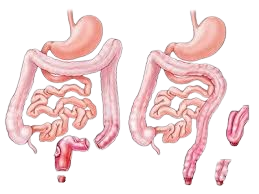Services
Laparoscopic Low Anterior Resection

This surgery removes the lower part of the colon and the upper part of the rectum using small cuts in the belly. It’s a minimally invasive way to treat cancer or other problems in the lower rectum.
Indications for Surgery:
Rectal Cancer: To remove cancer in the lower rectum while trying to keep as much of the rectum as possible.
Benign Tumors or Polyps: To take out non-cancerous growths that might cause problems or could turn into cancer.
Inflammatory Bowel Disease (IBD): Sometimes done for severe Crohn’s disease or ulcerative colitis that affects the rectum.
Procedure:
Anesthesia: You’re put to sleep, so you won’t feel anything during the operation.
Small Cuts: About 4–5 small cuts are made in your belly.
Camera Inserted: A small camera (called a laparoscope) goes in to show the inside of your belly on a screen.
Using Special Tools: The surgeon uses thin tools through the other cuts to do the surgery.
Removing the Affected Part: The lower colon and part of the rectum with the problem are removed, along with nearby tissue or lymph nodes if needed.
Reconnecting the Bowel: The remaining rectum is connected to the colon so you can still pass stool normally. Sometimes a new pouch is made to help store stool.
Closing the Cuts: The small cuts are closed with stitches or glue.
Advantages of Laparoscopic Colorectal Resection:
Smaller Cuts: Means less pain, less scarring, and a quicker recovery.
Faster Healing: You can go home sooner and get back to normal life more quickly.
Lower Risk of Infection: Smaller cuts mean less chance of getting an infection.

